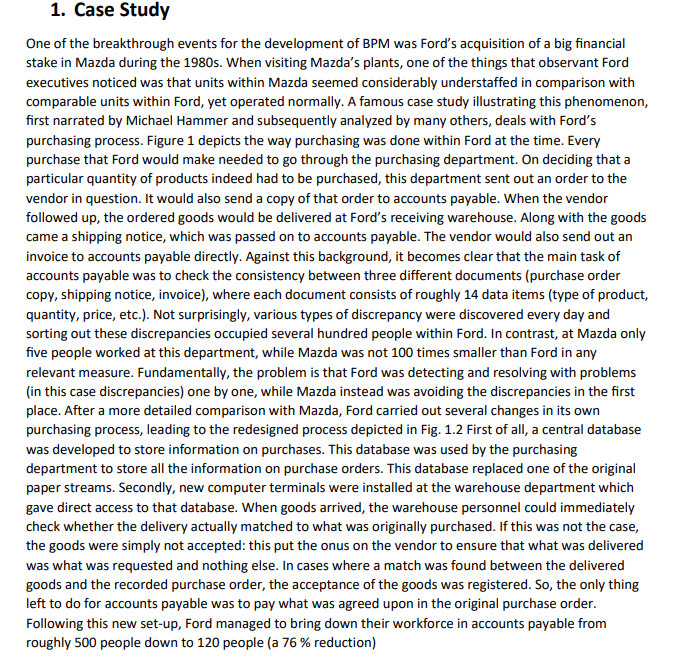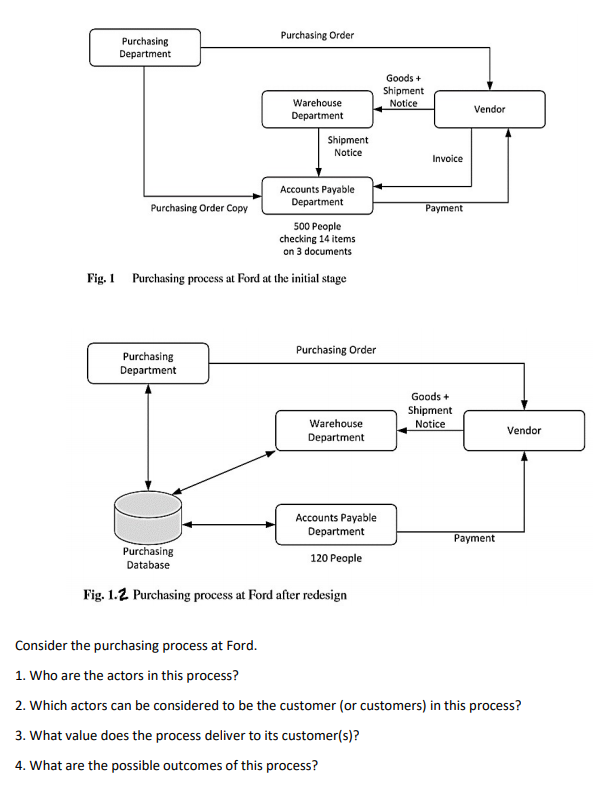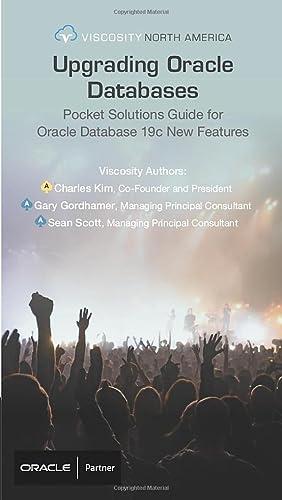Answered step by step
Verified Expert Solution
Question
1 Approved Answer
NOTE: Answer the following question..... 1. Case Study One of the breakthrough events for the development of BPM was Ford's acquisition of a big financial


NOTE:
Answer the following question.....
1. Case Study One of the breakthrough events for the development of BPM was Ford's acquisition of a big financial stake in Mazda during the 1980s. When visiting Mazda's plants, one of the things that observant Ford executives noticed was that units within Mazda seemed considerably understaffed in comparison with comparable units within Ford, yet operated normally. A famous case study illustrating this phenomenon, first narrated by Michael Hammer and subsequently analyzed by many others, deals with Ford's purchasing process. Figure 1 depicts the way purchasing was done within Ford at the time. Every purchase that Ford would make needed to go through the purchasing department. On deciding that a particular quantity of products indeed had to be purchased, this department sent out an order to the vendor in question. It would also send a copy of that order to accounts payable. When the vendor followed up, the ordered goods would be delivered at Ford's receiving warehouse. Along with the goods came a shipping notice, which was passed on to accounts payable. The vendor would also send out an invoice to accounts payable directly. Against this background, it becomes clear that the main task of accounts payable was to check the consistency between three different documents (purchase order copy, shipping notice, invoice), where each document consists of roughly 14 data items (type of product, quantity, price, etc.). Not surprisingly, various types of discrepancy were discovered every day and sorting out these discrepancies occupied several hundred people within Ford. In contrast, at Mazda only five people worked at this department, while Mazda was not 100 times smaller than Ford in any relevant measure. Fundamentally, the problem is that Ford was detecting and resolving with problems (in this case discrepancies) one by one, while Mazda instead was avoiding the discrepancies in the first place. After a more detailed comparison with Mazda, Ford carried out several changes in its own purchasing process, leading to the redesigned process depicted in Fig. 1.2 First of all, a central database was developed to store information on purchases. This database was used by the purchasing department to store all the information on purchase orders. This database replaced one of the original paper streams. Secondly, new computer terminals were installed at the warehouse department which gave direct access to that database. When goods arrived, the warehouse personnel could immediately check whether the delivery actually matched to what was originally purchased. If this was not the case, the goods were simply not accepted: this put the onus on the vendor to ensure that what was delivered was what was requested and nothing else. In cases where a match was found between the delivered goods and the recorded purchase order, the acceptance of the goods was registered. So, the only thing left to do for accounts payable was to pay what was agreed upon in the original purchase order. Following this new set-up, Ford managed to bring down their workforce in accounts payable from roughly 500 people down to 120 people (a 76 % reduction) Purchasing Order Purchasing Department Goods + Shipment Notice Warehouse Department Vendor Shipment Notice Invoice Payment Accounts Payable Purchasing Order Copy Department 500 People checking 14 items on 3 documents Fig. 1 Purchasing process at Ford at the initial stage Purchasing Order Purchasing Department Goods + Shipment Notice Warehouse Department Vendor Accounts Payable Department 120 People Payment Purchasing Database Fig. 1.2 Purchasing process at Ford after redesign Consider the purchasing process at Ford. 1. Who are the actors in this process? 2. Which actors can be considered to be the customer (or customers) in this process? 3. What value does the process deliver to its customer(s)? 4. What are the possible outcomes of this processStep by Step Solution
There are 3 Steps involved in it
Step: 1

Get Instant Access to Expert-Tailored Solutions
See step-by-step solutions with expert insights and AI powered tools for academic success
Step: 2

Step: 3

Ace Your Homework with AI
Get the answers you need in no time with our AI-driven, step-by-step assistance
Get Started


